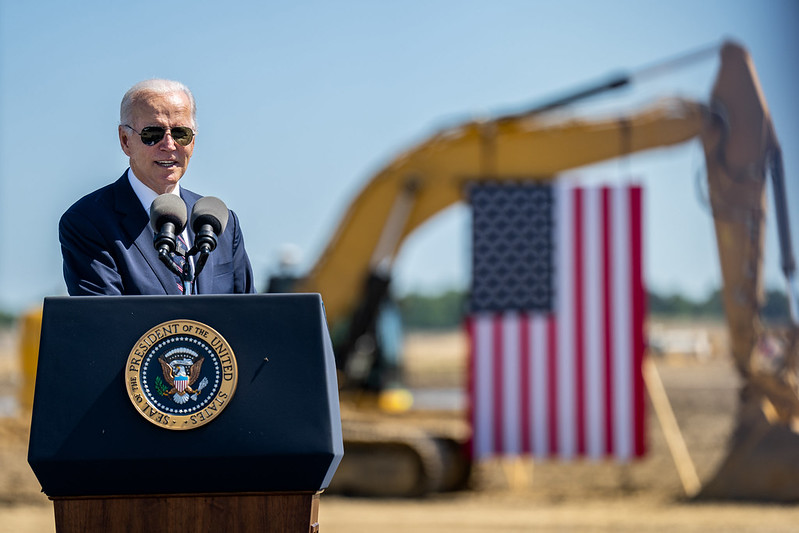
Congress can change that in 2023. Here are the trade policies it needs to prioritize for American competitiveness.
Editor’s note: The Alliance for American Manufacturing team is counting down the top manufacturing news stories of 2022 all this week. Read No. 5, No. 4, and No. 3.
If you played pandemic bingo, you would surely have seen “semiconductors” somewhere on the board, along with “lockdown,” “N95,” and “toilet paper.” Ahhh, the heady days of COVID’s onset… How I do not miss you!
From 2020 until 2022, chronic semiconductor shortages plagued the United States auto industry and complicated the production of everything from smartphones to dishwashers to missiles. Then, on Aug. 9, 2022, President Joe Biden signed the bipartisan CHIPS and Science Act of 2022 into law, establishing a landmark $52 billion fund to build more resilient and advanced semiconductor supply chains.
The investment came at a critical time as America’s global competitors doubled down on supporting their own semiconductor fabricators. The U.S. was once a global leader in the industry, with 37% of semiconductor manufacturing capacity located in the U.S. in 1990, but only 12% today. Meanwhile, an overwhelming 75% of global semiconductor production comes from East Asia.
Commerce Secretary Gina Raimondo, who is charged with overseeing the dispersal of the CHIPS fund, called the law “a historic investment that will help revitalize the U.S. domestic manufacturing economy, spur research and development in critical industries, and enable us to continue outcompeting and out-innovating the rest of the world.”
From the time that the CHIPS Act legislation was first introduced in the spring of 2020 until now, America has seen more than 40 new semiconductor ecosystem projects announced, according to Semiconductor Industry Association tracking. In total, the projects amount to nearly $16 billion in private investments across 16 states, with 40,000 new jobs expected as the projects come to fruition.
Here are just some of the most notable investments: Intel’s $20 billion fabricators in New Albany, Ohio, which is expected to directly create 3,000 new jobs; Taiwan Semiconductor Manufacturing Company’s $40 billion expansion plan for a new production hub in Phoenix, Ariz.; and Micron’s $100 billion factory in Clay, N.Y.
This is all truly great news! But there’s more work to be done.
Come 2023, we’re hoping to see Congress prioritize passing legislation that addresses the role of trade in American competitiveness. Of particular importance are the Leveling the Playing Field Act 2.0, de minimis reform, and Trade Adjustment Assistance (TAA).
Though Leveling the Playing Field Act 2.0 did not make it into the CHIPS Act, it was part of the House’s version of the bill. We advocated for the legislation’s inclusion at the time because of its role in ensuring American competitiveness.
The CHIPS Act puts a ton of money on the table to incentivize the development of a robust and advanced semiconductor ecosystem in the United States, but for the nation to truly meet the challenges of competition today, the U.S. must modernize its trade law.
Among other trade tools in the bill, the Leveling the Playing Field Act 2.0 (also called Eliminating Global Market Distortions to Protect American Jobs Act) would strengthen antidumping and countervailing duty laws, with a focus on countering the “whack-a-mole” problem that haunts U.S. manufacturers even after they have successfully fought for trade remedies. Too often, as we’ve seen in the American steel industry and solar industry, bad actors like China avoid tariffs that have been imposed on their products, after being found to violate trade law, by shipping the same products through other countries. Leveling the Playing Field Act 2.0 would help address this circumvention as well as provide other valuable trade tools.
It’s also well past time that the U.S. close an import tariff loophole that bad trade actors and their corporate accomplices have exploited to import its clothing duty-free. (We’re looking at you, Shein.) Introduced in January 2022, The Import Security and Fairness Act would prohibit the use of the de minimis threshold, which allows imports valued at less than $800 to enter the U.S. without a formal import process, duties or taxes, on goods imported from countries that are both non-market economics and on the U.S. Trade Representative’s Watch List.
Meanwhile, workers who have been victimized by unfair trade like circumvention are left out in the cold without TAA, which expired on June 30, 2022. The program helps retrain workers whose jobs have been impacted by foreign trade and has served more than five million American workers since its establishment in 1962. Today, Americans who see their jobs eliminated or wages reduced due to unfair trade disruptions no longer have access to this valuable program. If the U.S. is serious about establishing preeminence in the industries of the future, it must protect the American men and women who suffer the brunt of unfair trade practices.
In 2022, the CHIPS Act offered the nudge that the world’s biggest semiconductor companies needed to invest in American workers, but without trade law modernization in 2023 those same workers are at the mercy of nations like China that routinely flout global trade laws.
